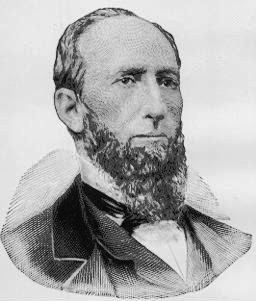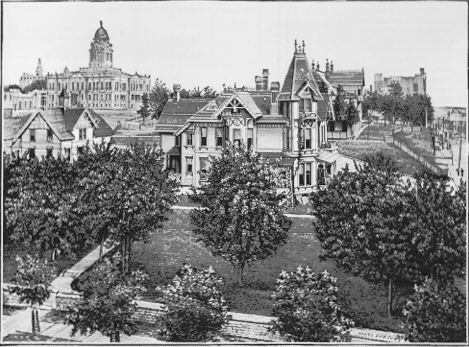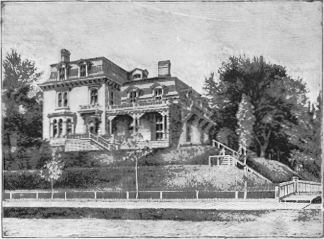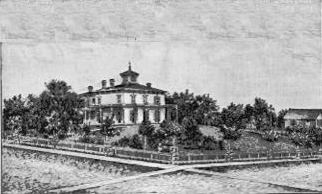|
OMAHA
ILLUSTRATED.
satisfactory, and the tribes signed the
documents during the months of March and April. They were
then removed to the reservation provided for them.
THE CITY SURVEYED AND
PLATTED.
The Indian
title to the land being extinguished, and the territorial
organic act having been passed, the time had now come for
the ferry company to carry out their proposed plan of
founding a city. The company accordingly employed Mr. A. D.
Jones, who was a surveyor,
|
[Jesse Lowe
was born in Raleigh, Rowan county, North Carolina,
March 11, 1814. Soon afterward his parents removed
to the then territory of Indiana, and settled in
Monroe county, near Bloomington. As a boy Mr.
Lowe's experience was that usual to boys on a farm
in a newly settled country, but later he succeeded
in obtaining a fair education at Bloomington
College, Indiana. He then entered the law office of
Gen. Tilghman Howard of that State (who was a
gentleman of distinction in those days, and had
|
|
represented our government in Spain), and
studied law, but did not then seek admission to the
bar. His disposition craved change and outdoor
occupation, rendered necessary in part by ill
health, and he spent some years in traveling
through the South, being often in Memphis, New
Orleans, etc., and to a considerable extent engaged
in purchasing stock for the army. At the breaking
out of the Mexican war, being in Missouri, he
entered a regiment raised by Sterling Price, as
Commissary. He was afterward promoted to Paymaster,
and served until the war closed.
His elder brother, Dr. Enos Lowe,
having removed to Burlington, Iowa, in 1837, was at
the close of the war Receiver of Public Moneys at
Iowa City, and Jesse joined him there; and when in
1853 the doctor was made Receiver at Kanesville
(now Council Bluffs), his brother accompanied him
to the new station, assisted in the duties of
|

THE LATE JESSE LOWE.
|
the office, and was the messenger to carry the
public funds to Iowa City for deposit. At this time
Nebraska belonged to the Pawnees, Omahas and other
Indian tribes, and Jesse Lowe, looking across the
river one day, pointed to the present site of Omaha
and said to his companions: "There is the place for
a great city, and in time there will be one there.
Why should we not begin it?" His friends assented,
and on July 3, 1853, they crossed the river in a
skiff, Jesse Lowe and Jesse Williams having to wade
part of the way, and located their claims. Jesse
Lowe took up a quarter-section of land about the
western end of Cuming street (to which he
subsequently added by purchase three other
quarter-sections, making in all 640 acres), and
within a week had a man with a mule team at work
upon his "Ranche," which he subsequently called Oak
Grove Farm. In 1854, the Indian title to the land
having been extinguished by
|
|
the Government, the city was surveyed, platted,
and fairly begun, the name of its former Indian
owners being given to it by Mr. Lowe, and a "claim
club" was organized May 28, of which Mr. Lowe was a
member. This club built a small house on wheels,
which was moved from one claim to another, and
served as the home of each claimant in turn during
the necessary periods of personal occupancy
required by law. The old "claim house" found its
last resting place on Ninth street, and is now the
flat-roofed portion of the one-story house, 413
South Ninth street, across the alley on the south
side of the Cozzens Hotel. At the time Mr. Lowe
settled in Omaha he had, as a result of his former
business enterprises and savings, what were
considerable means for those days, and he
established himself in the real estate business,
which he continued until his death. He had also the
exclusive privilege of trading with the Indian
tribes at the adjacent agency. When the Territory
was organized he was admitted to the bar, but never
practiced. He built the first banking house (almost
the first brick building in Omaha), which, after
years of occupancy by different private banking
firms, became the United States National Bank, and
was early in 1887 torn down to give place to a fine
modern building of stone. In 1857, the city having
obtained a charter, Mr. Lowe was elected its first
mayor, and J. M. Woolworth was the first city
attorney. The parents of Mr. Lowe being strict
"Friends," or Quakers, his early training in the
principles of that sect shaped and governed his
whole life, although in his later years he became a
member of the Lutheran church. He was an excellent
financier, of sound judgment, ready at all times to
aid in anything calculated to promote the
advancement of Omaha, and enjoyed to the last the
unqualified respect and confidence of his fellow
citizens. He died April 3, 1868.]
|
to survey the site, covering the claims
of the company. Mr. Jones spent the greater portion of the
month of June and a part of July in this work, in which he
was assisted by Mr. C. H. Downs, who carried the chain and
drove the stakes. The city was laid out in 322 blocks, each
264 feet square. The streets were made 100 feet wide, except
Capitol avenue, which
[8]
|



